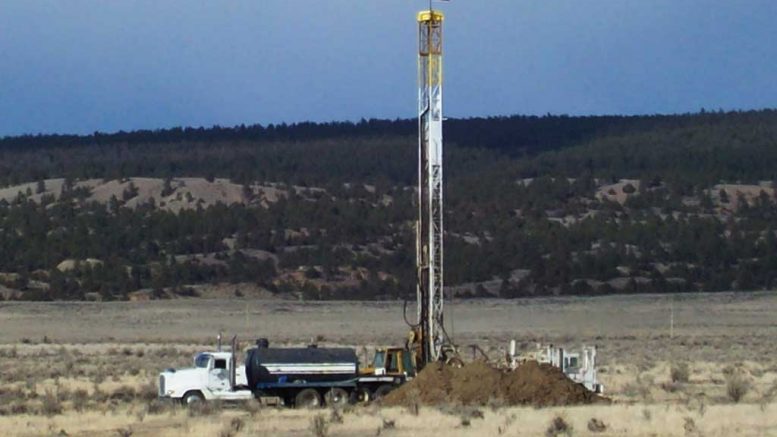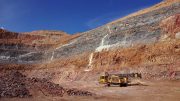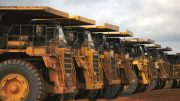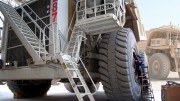The Northern Miner presents the top-10, U.S.-based mid-tier to junior companies, excluding coal and precious metals, by market capitalization, as of July 24, 2020.
1. Compass Minerals
Market cap: US$1.8 billion
Compass Minerals (NYSE: CMP) produces plant nutrients, salts and magnesium chloride for applications in industrial, agricultural, commercial and consumer markets, primarily in North America.
The Kansas-headquartered company is the number one producer in the U.S. of sulphate of potash (SOP), an organic fertilizer used for crops that require high potassium such as soybeans, corn, vegetables and tree nuts. The company operates production facilities in the U.S. and Canada and has cornered between 70% and 80% of the SOP market in North America. Last year it sold 10.5 million tonnes of SOP worth about US$591 million.
Compass is also the leading supplier of highway de-icing products in North America and the U.K. and operates three underground salt mines: the Cote Blanche mine in Louisiana, which produces nearly 15% of highway de-icing salt in the U.S., the Goderich mine in Ontario, the largest salt mine in the world, and the Winsford rock salt mine in Cheshire, the U.K.’s largest and oldest working mine, which began in 1844 when local prospectors started searching for coal at the site.
Compass also operates a solar evaporation plant in the U.S. and mechanical evaporation plants in the U.S. and Canada. In 2019, the company produced 10 million tonnes of salt for sales worth US$890 million.
2. Uranium Energy
Market cap: US$186 million

Uranium Energy’s Palangana in-situ recovery uranium mine in south Texas. Credit: Uranium Energy.
Uranium Energy (NYSE-AM: UEC) is a uranium exploration and mining company headquartered in Corpus Christi, Texas. The company’s hub-and-spoke operations are anchored around its Hobson uranium processing facility, located 160 km northwest of Corpus Christi, which is central to its Palangana mine, Burke Hollow project and Goliad in-situ recovery (ISR) project.
The Palangana mine contains measured and indicated resources of 440,160 tonnes grading 0.135% uranium oxide (U3O8) for 1.06 million contained lb. U3O8 and inferred resources of 367,360 tonnes of U3O8 grading 0.176% U3O8 for 1.15 million lb. U3O8 at a cutoff grade of 0.5 gram per tonne.
Uranium Energy’s other North American uranium projects include the Reno Creek project, the largest permitted ISR uranium project in the U.S., located in northeast Wyoming; the Salvo and Longhorn projects in Texas; the Anderson, Los Cuatros, and Workman Creek projects in Arizona; and the Dalton Pass and Ce de Baca projects in New Mexico. It also controls the Diabase early-stage uranium project in Saskatchewan, Canada; and the Long Park and Slick Rock uranium-vanadium projects in Colorado.
The company’s South American assets include the Oviedo and Yuty ISR uranium projects and the Alto Parana titanium project, all located in Paraguay.
3. Texas Mineral Resources
Market cap: US$154 million
Texas Mineral Resources (US-OTC: TMRC) is a mineral exploration company targeting heavy rare earth elements (REEs), technology metals and industrial minerals. The company is developing its flagship Round Top REEs and critical minerals project, located 13 km northwest of Sierra Blanca and 137 km southeast of El Paso, Texas.
A 2019 preliminary economic assessment (PEA) of the project forecasts annual production of 2,213 tonnes REEs, including 1,910 tonnes heavy REEs, over a mine life of 20 years. The study estimates an initial capex of US$350.4 million and a payback period of 1.4 years.
The PEA estimated total annual revenue of US$396 million, with 51% coming from technology metals, 26% from heavy REEs, 20% from industrial minerals, and 3% from light REEs.
In 2019, Texas Mineral signed a development agreement with USA Rare Earth. Under the agreement, USA Rare Earth needs to first spend US$2.5 million to complete the optimization of the separation and purification processes and then spend an additional US$7.5 million to produce a bankable feasibility study on Round Top to earn up to a 70% interest in the project, and can thereafter earn up to an additional 10% interest in the project for a US$3 million cash payment to the company.
4. NioCorp Developments
Market cap: US$149 million

Drill rigs at NioCorp Developments’ Elk Creek niobium project in southeastern Nebraska in 2015. Credit: NioCorp Developments.
NioCorp Developments (TSX: NB; US-OTC: NIOBF) is focussed on its Elk Creek niobium-scandium-titanium project in south-eastern Nebraska. Once built, Elk Creek would be the highest grade niobium mine in North America and one of the largest producers of scandium in the world, with a materials manufacturing facility and an underground mine situated on the property.
A 2019 feasibility study estimates average annual production of 7,220 tonnes ferroniobium, 95 tonnes scandium trioxide, and 11,642 tonnes titanium dioxide over a mine life of 36 years.
The study estimates a total net capex of US$1.14 billion and an after-tax payback period of just under three years. The project is forecast to have a net present value of US$2.1 billion at an 8% discount rate and an after-tax internal rate of return of 25.8%.
The project contains indicated mineral resources of 183.2 million tonnes grading 0.54% ferroniobium, 57.65 grams scandium per tonne, and 2.15% titanium dioxide for 981,092 tonnes contained ferroniobium, 3.9 million tonnes titanium dioxide, and 10.6 million tonnes scandium.
Ferroniobium is a critical component of high-strength, low-alloy steel, and scandium trioxide is used in high-performance aluminium alloys and solid oxide fuel cells. Titanium oxide is used in the manufacture of pigments in paints, plastics and paper, and as a photo-catalyst, and titanium is used in the aerospace, defence and automotive industries.
5. Intrepid Potash
Market cap: US$119 million
Intrepid Potash (NYSE: IPI) supplies high-quality potassium, magnesium, sulphur and salt products to the agricultural, animal feed and chemicals industry.
The company is the only producer of muriate potash (potassium chloride) in the U.S., supplying 3.5% of the country’s annual consumption. It sells potash in granular, standard and fine standard sizes, with the granular-size predominantly sold to agriculture markets, while the standard-size is primarily sold to animal feed and industrial markets.
Intrepid operates three solar evaporation potash and salt mines: Carlsbad in New Mexico, and Wendover and Moab in Utah.
The company also owns the East mine, an underground langbeinite mine in Carlsbad, which sits on one of the world’s largest known reserves of langbeinite. Langbeinite is a naturally occurring fertilizer that the company sells under the brand name Intrepid Trio.
In 2019, the company produced 1.5 million tonnes potash and 856,000 tonnes Trio. It also produces magnesium chloride, metal recovery salts, brines and water derived from its mining processes.
6. Ur-Energy
Market cap: US$96 million

The processing facility at Ur-Energy’s Lost Creek in-situ recovery uranium mine in Wyoming. Source: Ur-Energy
Ur-Energy’s (TSX: URE; NYSE-AM: URG) portfolio includes 12 uranium projects, ten of which are located in the Great Divide Basin of Wyoming, including its flagship Lost Creek in-situ recovery uranium facility, located 61 km northwest of Rawlins.
In 2016, an updated preliminary economic assessment (PEA) for Lost Creek forecasts total production of 13.8 million lb. uranium over a mine life of 19 years. The early-stage study estimates an initial capex of US$46.5 million. The project is forecast to have an after-tax net present value of US$208 million at an 8% discount rate and an after-tax internal rate of return of 50.9%.
The company also operates the Shirley Basin project in central-southeast Wyoming, located 64 km south of Casper city. A PEA in 2015 forecast total production of 6.3 million lb. uranium over a mine life of 14 years. The initial capex was estimated to be US$30.6 million.
Ur-Energy’s other properties include the Lost Solider uranium project, located 22.5 km northeast of its Lost Creek project, and the Lucky Mc uranium mine situated in the Gas Hills mining district of Wyoming.
7. General Moly
Market cap: US$49 million

General Moly’s Liberty moly-copper project near Tonopah, Nevada. Credit: General Moly.
General Moly (TSX: GMO; NYSE-AM: GMO) is a mineral exploration and development company primarily focussed on molybdenum. The company has two projects in Nevada: its flagship Mt. Hope molybdenum project and its wholly owned Liberty molybdenum-copper project.
The company holds an 80% interest in Mt. Hope, with the remaining 20% owned by POS-Minerals, a subsidiary of South Korean steel company POSCO. The property is located 34 km north of Eureka.
General Moly has invested US$299 million in permitting, pre-construction, and long-lead equipment at Mt. Hope and requires a further US$1.03 billion in capital investment. The company is seeking additional financing, which it says is contingent on higher and sustained molybdenum prices.
The company describes Mt. Hope as one of the largest and highest grade primary molybdenum deposits in the world.
Liberty is also considered another world-class molybdenum project, with measured and indicated resources of 281 million tonnes at an average grade of 0.08% molybdenum for 482 million contained lb. molybdenum.
8. Scandium International Mining
Market cap: US$32 million

Drillers at Scandium International Mining’s Nyngan scandium project in Australia. Credit: Scandium International Mining.
Scandium International Mining (TSX: SCY; US-OTC: SCYYF) hopes to become the first company to achieve production from a primary scandium mine. It owns the Nyngan scandium project in Australia, located about 25 km west of the town of Nyngan and 450 km northwest of Sydney. The project is shovel-ready and slated for completion in 2021.
A definitive feasibility study for the project in 2016 estimated average annual production of 38 tonnes of scandium oxide at a grade of 98-99.9% over a 20-year mine life. The study forecasts a capex of US$87 million and a payback period of 3.3 years. The project is estimated to have an after-tax net present value of US$177.5 million at a 10% discount rate and an after-tax internal rate of return 33.1%.
The company’s other assets include the wholly-owned HoneyBugle scandium project adjacent to Nyngan, and the Kiviniemi scandium property, located 350 northeast of Helsinki in Finland.
9. Azarga Uranium
Market cap: US$26 million

An antelope near a drill site at Azarga Uranium’s Dewey Burdock uranium project in South Dakota. Credit: Azarga Uranium.
Azarga Uranium (TSX: AZZ; US-OTC: AZZUF) is a uranium exploration and development company and holds several major uranium deposits across South Dakota, Wyoming, Colorado and Utah. The company is focussed on developing its advanced-stage Dewey Burdock project, an in-situ recovery uranium project located 26 km northwest of Edgemont, South Dakota.
In January, a preliminary economic assessment (PEA) for the project estimates annual production of 1 million lb. uranium oxide over a mine life of 21 years. The early-stage study forecasts an initial capex of US$31.7 million. The project is estimated to have an after-tax net present value of US$147.5 million at an 8% discount rate and an after-tax internal rate of return of 50%.
Azarga’s other assets include the Gas Hills and Juniper Ridge uranium projects in Wyoming, the Centennial project in Colorado, the JB project in Colorado, and the Ticaboo project in Utah, which contains three uranium stockpiles.
10. Solitario Zinc
Market cap: US$25 million
Solitario Zinc (TSX: SLR; NYSE-AM: XPL) is a zinc-focussed exploration and development company headquartered in Wheat Ridge, Colorado. It has joint venture interests in two zinc projects: Florida Canyon in northern Peru and Lik in northwestern Alaska.
Florida Canyon is operated by Minera Bongara, a joint venture between Solitario and Nexa Resources (TSX: NEXA; NYSE: NEXA), the world’s fourth-largest zinc producer. Nexa currently holds a 61% interest in the joint venture, but is earning a 70% stake by funding 100% of all future costs until a feasibility study is completed. Once it earns its 70% stake, Nexa will fund Solitario’s 30% portion of construction costs under a loan facility that will be repaid from 50% of the mining operation’s cash flow.
A preliminary economic assessment completed on the project in August 2017 envisioned an underground operation with a mine life of 12.5 years with annual production of 111.7 million lbs. of zinc, 12.6 million lbs. of lead, and 160,000 oz. of silver.
Solitario’s large tonnage and open-pittable Lik zinc deposit in Alaska is a 50:50 joint venture between Solitario and Teck American, a wholly-owned subsidiary of Teck Resources (TSX: TECK.A/TECK.B; NYSE: TECK). The project is 22 km from Teck’s Red Dog mine, one of the largest and lowest-cost zinc mines in the world. The Lik project consists of 47 contiguous mining claims covering approximately 2,225 hectares.
Solitario also has a 9.97% stake in Vendetta Mining (TSXV: VTT; US-OTC: VDTAF), a junior exploration company that controls the Pegmont lead-zinc project in Queensland, Australia.





Be the first to comment on "Top 10 US-based mid-tiers to juniors, excluding coal and precious metals"